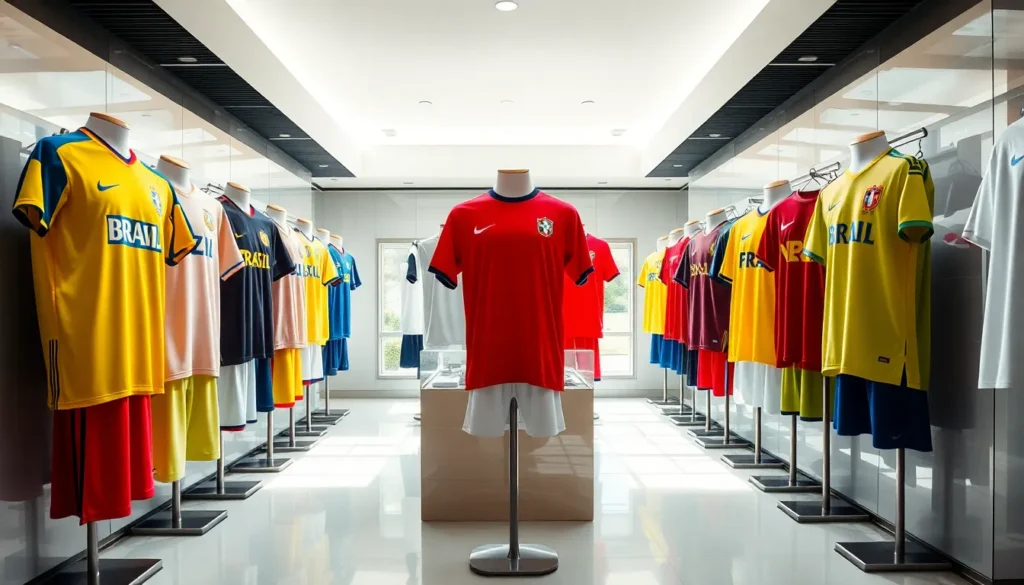Table of Contents
ToggleFIFA jerseys are more than just clothing worn by players: they represent national pride, history, and a touch of personal flair. Ever dreamt of dribbling like Messi or defending like Ramos? Well, grabbing the latest jersey is half the battle in feeling like a world-class player. With each tournament, these jerseys evolve, flaunting new designs and technologies that keep fans on their toes. In this guide, we’ll jump into the evolution of FIFA jerseys, dissect their design elements, and even explore what the future holds. Grab a seat: this will be a thrilling ride.
The Evolution of FIFA Jerseys

The journey of FIFA jerseys began in the early 20th century, when players donned simple, cotton creations that prioritized function over flair. Initially, these jerseys were often just plain colors, helping to distinguish the teams amidst muddy fields and enthusiastic crowds. But, by the 1950s, the landscape started shifting. Colors became bolder, and teams began to embrace their unique identities.
Fast forward to the 1970s, when technological advancements allowed for intricate designs and lightweight materials. This era marked the debut of famous jerseys, including the iconic Brazil shirt, known for its vibrant yellows and greens. Fast forward another few decades, and FIFA jerseys have transformed into a blend of art and technology. Designs now incorporate sublimation printing, allowing for stunning graphics that can withstand the test of time and wear.
Today, teams are not just showcasing colors: they are telling stories. Each jersey carries a piece of history, achievements, and aspirations, making them coveted items for fans worldwide.
Key Design Elements of FIFA Jerseys
Designing a FIFA jersey is not just about slapping a logo on a fabric. Several key elements come into play, ensuring that the jersey not only looks dynamic but also feels comfortable during intense gameplay.
First, there’s the color palette. While certain colors represent national identities, each shade carries psychological weight. For instance, red can symbolize power, while blue often stands for calmness. Next, one cannot overlook the cut of the jersey. Today’s designs favor a more athletic fit, enhancing mobility and breathability.
Then there’s the fabric. Modern jerseys often use advanced materials that wick moisture away from the skin. This ensures players remain dry and comfortable, even during high-stakes matches. Logos and team badges are strategically placed to maintain a cohesive design while also asserting brand dominance. Each element works synergistically, creating a work of art worn with pride.
Popular FIFA Jerseys Through the Years
Some jerseys become legends in their own right, and the conversation about iconic FIFA jerseys wouldn’t be complete without mentioning a few standouts.
For example, the 1998 France jersey, with its classic blue design adorned with a rooster emblem, is cherished among fans. It symbolizes the country’s first World Cup victory, creating a profound emotional connection. Likewise, the Brazil 1970 jersey is forever etched in history, celebrated for its vibrant colors and the legendary players who wore it.
In more recent times, the 2014 Germany jersey, which led the team to World Cup glory, stands out for its sleek design and historical significance. These jerseys tell the tale of triumph and heartbreak, demonstrating how a simple garment can encapsulate the spirit of a nation.
The Impact of Technology on Jersey Fabric and Design
Technological advances are driving innovations in jersey design, shaping how players and fans experience the game. Manufacturers now harness cutting-edge materials that enhance performance. Consider moisture-wicking fabrics designed to draw sweat away, ensuring players stay cool under pressure.
Also, many companies are experimenting with environmentally friendly materials, reflecting a modern awareness of sustainability. This means that the next wave of jerseys could not only perform better but also represent a commitment to the planet.
Then there’s the use of 3D printing technology, enabling intricate designs that were previously unattainable. Fans can now enjoy custom jerseys featuring personalized names or numbers, merging individual expression with team loyalty in stunning new ways. These advances not only raise the bars for comfort and performance, but they also make each jersey a unique statement piece.
Collecting and Buying FIFA Jerseys
For many fans, collecting FIFA jerseys is akin to pursuing a treasure hunt. Some fans begin by purchasing jerseys from their favorite teams, while others seek out limited editions and vintage styles that tell a story. Online marketplaces, official team stores, and specialty fan shops are goldmines for collectors.
But, the vast array of options can also present challenges. Authenticity becomes a critical factor, especially for limited-edition jerseys that can fetch higher resale prices. Collectors must be cautious, ensuring they obtain jerseys with verified authenticity to avoid counterfeit disaster.
Condition is paramount as well: a well-preserved jersey can increase in value over time. Whether for personal enjoyment or investment lines, gathering these jerseys brings fans closer to the world of football, creating connections over shared love.
The Future of FIFA Jerseys
As the sport continues to evolve, so too will FIFA jerseys. The future looks to integrate even more advancements in technology, promising to enhance both player and fan experiences. Imagine jerseys embedded with sensors to track player performance live during matches or enhanced materials that adapt based on weather conditions.
Fashion and football are increasingly intertwined: we could see collaborations with high-end designers, pushing the envelope of style both on and off the pitch. Such partnerships might elevate the jersey to a wardrobe staple, relevant beyond the stadium.
Besides, there’s a shift towards inclusivity in designs. Expect to see more variations catered to different body types and needs, making it clear that football truly is for everyone. The future of FIFA jerseys holds exciting prospects that bridge the gap between sport, fashion, and technology.






